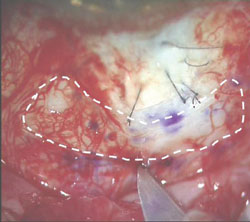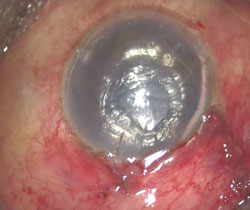Rotational lamellar scleral flap technique useful for bleb leak
The new technique offers advantages over the use of donor sclera or other material for patch grafting.
 Amar Agarwal |
Bleb leaks are one of the complications of trabeculectomy surgery observed in either the early or late postoperative period. This has to be managed aggressively, since untreated bleb leaks are well-known to cause serious, eye-threatening problems. This may range from a postoperative flat anterior chamber to devastating endophthalmitis. In this column, we describe a new technique of rotational lamellar scleral flap for surgical repair in those patients with bleb leak due to buttonholing or necrosis of the scleral flap.
Bleb leak
Bleb leak is commonly associated with the use of adjunctive antimetabolites. Several surgical procedures have been described for the repair of leaking filtering blebs, of which conjunctival advancements and conjunctival patch grafts are the most commonly employed. Other techniques that are used include scleral patch grafts with conjunctival advancement, buccal mucous membrane patch grafts and corneal stromal patch grafts.
Bleb revision
Initially, the conjunctiva and Tenon’s capsule over the bleb are incised. The underlying scleral flap is checked for tightness of the sutures, buttonhole or bed necrosis. One can inject air in the anterior chamber and notice the air bubbles escaping if there is a buttonhole (Figure 1). Tight sutures or scleral bed necrosis has to be observed clinically under the microscope.
Rotational flap
The size of the rotational flap required to patch the scleral defect is determined with calipers. The sclera from the area adjacent to the original flap is marked out to fashion the rotational flap (Figure 2). The base of the flap is oriented to one side of the trabeculectomy site, either temporal or nasal to the existing flap. The length of the flap should be longer than the existing graft, whereas the width can be variable. The surgeon should make sure that the width of the flap covers the buttonhole. The lamellar scleral flap, half the scleral thickness, is cut along the marked dimensions with one end still attached to the original scleral bed. Adequacy of the size of the flap has to be ascertained once this is done.
 Figure 1. The escape of air bubbles (arrow) on injecting air into the anterior chamber confirms the buttonhole in the existing trabeculectomy flap. |
 Figure 2. The rotational lamellar scleral flap is cut along the mark (white dotted line) on the sclera. |
 Figure 3. The lamellar scleral flap is rotated over the existing scleral flap bed and sutured. |
 Figure 4. Anterior chamber is well-formed and conjunctiva apposed. Images: Agarwal A |
The flap is then released adequately at its base from the adjacent sclera and rotated over the trabeculectomy flap (Figure 3). The rotational flap is then secured to the underlying sclera at its free end and along the margins with nonabsorbable 10-0 nylon sutures. The anterior chamber is formed through a side port made in the clear cornea (Figure 4). The amount of filtration through the trabeculectomy is titrated, and additional sutures are placed if required. The conjunctiva and Tenon’s capsule are closed with continuous sutures.
Postoperative outcome
We operated on a patient with a diagnosed bleb leak after combined phacoemulsification with posterior chamber IOL implantation and trabeculectomy for chronic open-angle glaucoma. Postoperatively the patient had a clear cornea, a well-formed anterior chamber and an adequately functioning bleb. At 6 months postoperatively, his best corrected visual acuity was 20/30 with an IOP of 11 mm Hg off all IOP-lowering agents. A microcystic bleb with viable scleral flap was observed with anterior segment optical coherence tomography.
Rotational scleral flap vs. donor scleral patch graft
The repair of aqueous leaks in the presence of friable scleral problems has been performed by using various materials, such as donor sclera, pericardial grafts and corneal stromal grafts. Donor scleral patch grafts are useful to manage hypotony due to leaking or overfiltering blebs associated with scleral melting that precludes effective suturing and closure of the wound leak. The technique has been combined with conjunctival advancements and amniotic membrane grafts. Donor scleral grafts, however, are associated with complications such as infectious endophthalmitis and graft necrosis.
This rotational flap technique offers advantages over the use of donor sclera or other material for patch grafting. Unlike material such as preserved human pericardium, the flap is not difficult to procure. The procedure can easily be done by surgeons who may not have access to the eye banking and donor sclera facilities. It is also a cost-effective procedure, requiring no additional material. Because the flap is an autograft, the risk of flap necrosis is minimal. Moreover, the principle behind any rotational flap surgery is that the flap has a feeder vessel at its base that nourishes it and prevents necrosis. The risk of exogenous infection that is associated with the use of allografts or preserved tissue is also negated.
Conclusion
This novel technique of a lamellar scleral rotation flap to plug aqueous leaks through a buttonhole or necrotic area of the scleral flap or a necrotic scleral bed after trabeculectomy is a simple alternative for tackling filtering bleb leaks. Clinical studies involving several patients and a longer follow-up are required to establish the long-term anatomical and functional outcomes of this surgical procedure.

- Amar Agarwal, MS, FRCS, FRCOphth, is director of Dr. Agarwal’s Eye Hospital and Eye Research Centre. Prof. Agarwal is the author of several books published by SLACK Incorporated, publisher of Ocular Surgery News, including Phaco Nightmares: Conquering Cataract Catastrophes, Bimanual Phaco: Mastering the Phakonit/MICS Technique, Dry Eye: A Practical Guide to Ocular Surface Disorders and Stem Cell Surgery and Presbyopia: A Surgical Textbook. He can be reached at 19 Cathedral Road, Chennai 600 086, India; fax: 91-44-28115871; e-mail: dragarwal@vsnl.com; Web site: www.dragarwal.com.
